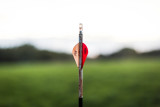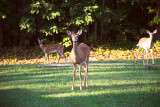
Opening mornings of gun seasons in whitetail-rich states like Wisconsin, Michigan, and Pennsylvania often sound like Civil War re-enactments. It makes me wonder how the woods can hold enough deer to trigger such fusillades.
Some deer get shot at more than once, of course, given that hunters typically carry autoloaders or bolt-, lever- or pump-action rifles or shotguns for quick follow-up shots or a coup de grâce.
Despite all the shooting, the deer woods grew increasingly safer the past 50 years as hunter education programs in Canada and the United States emphasized gun safety and pushed blaze orange requirements.
Still, North American hunting culture doesn’t embrace one-shot kills as a core value. It’s uncommon for American hunters and hunting clubs to ask partners to explain and justify follow-up shots. Such accountability is more common in European hunting groups. As Professor Thomas Heberlein at the University of Wisconsin-Madison explained in “The Gun, the Dog, and the Thermos: Culture and Hunting in Sweden and the United States,” Sweden’s hunt club members make everyone account for each shot.
A popular slogan explains a common North American belief: “You miss 100% of the shots you don’t take.” That’s not a modern attitude. Consider these thoughts from a famous American hunter:
“It is a good rule always to try to get as near the game as possible … At the same time, I am a great believer in powder-burning, and if I cannot get near, I will generally try a shot anyhow, if there is a chance of the rifle’s carrying to it. In this way, a man will now and then, in the midst of many misses, make a very good long shot, but he should not try to deceive himself into the belief that these occasional long shots are to be taken as samples of his ordinary skill. Yet it is curious to see how a really truthful man will forget his misses, and his hits at close quarters, and, by dint of constant repetition, will finally persuade himself that he is in the habit of killing his game at three- or four-hundred yards.”
The man behind those words is President Theodore Roosevelt, from his 1885 book “Hunting Trips of a Ranchman.” Yes, that’s TR; father of the Boone and Crockett Club and a founding force in the United States’ conservation movement.
Counting Blaukš!
For all that shooting, how many “Blaukš!” are taken per whitetail killed? Those ratios vary by hunter numbers, hunting experience, individual marksmanship, deer densities, deer movements, bag regulations, season lengths, day of season, hunting methods, and firearms types, to name a few complex factors.
A series of studies from the 1960s through the 1980s at Wisconsin’s Sandhill Wildlife Area suggest the more hunters afield in short seasons, the more intensely they compete to “get their deer,” especially during either-sex hunts. Sandhill is a state-owned, 9,000-acre, fenced research facility. The Sandhill studies documented 3.1 to 7.4 shots per deer bagged.
Studies elsewhere reported better shooting. Research in Ontario (1973) and South Carolina (mid-1990s) during herd-reduction hunts documented 1.6 and 1.2 shots per kill, respectively. Hunters in the South Carolina study shot off rests at an average distance of 132 yards. The lead researcher, Dr. Charles Ruth, used tracking dogs to verify hits, kills, and misses.
More recently, a study of United Kingdom deer hunting groups relied on the “subjective judgment and honesty” of anonymous hunters to calculate an average of 1.06 shots per kill. The Wisconsin and South Carolina studies relied on personal, more immediate post-hunt interviews and surveys.
Another noteworthy difference: Sandhill was a highly coveted hunt. Hunter numbers were restricted, and deer numbers elsewhere in Wisconsin during the 1960s and 1970s were far lower than today. Plus, Wisconsin hunters grew up in competitive environments featuring short seasons and hundreds of thousands of hunters. In 1972, Wisconsin had 518,000 gun hunters. For perspective, South Carolina had about 140,000 hunters and Ontario about 165,000 when those shot success studies were conducted.
Other Marksmanship Tests
How do those rates—whether it’s 1.2 shots or 7.4 shots per deer—compare to life-or-death exchanges involving soldiers on battlefields and police on urban streets?
Automatic, high-tech military weapons distort such comparisons, but what about that Civil War comparison that started this article? In his book “Gettysburg: The Last Invasion,” Allen C. Guelzo reports that Union General William S. Rosencrans calculated his troops took 27.5 cannon shots for each Rebel hit, and 145 rifle shots for each Rebel hit during the battle of Stones River in Tennessee in early January, 1863.
In contrast, private contractors who cull animals at airports, car test facilities, and other sites to remove deer, turkeys, or coyotes operate so methodically—almost robotically—that they seldom miss. Karl Malcolm, a wildlife biologist with the U.S. Forest Service in Albuquerque, worked for 10 years as an animal control sharpshooter at several sites, and killed hundreds of deer and turkeys with a .243 Winchester and copper bullets.
“I remember driving to jobs, knowing I had to 10 days to kill 50 deer,” Malcolm said. “In one job, I took 52 shots to kill 50 deer. Those aren’t hunting conditions. It’s not about fun or dealing with ‘buck fever.’ There’s no excitement or nervous anticipation.”
Malcolm shot with a bipod at 40 to 125 yards, often from atop a truck’s roof, and was very choosy in his shots. He said one lesson applies to hunting: “Your worst shots and poorest decisions occur after you’ve taken a bad shot,” he said. “Running deer make bad targets.”
Diminishing Returns
Wisconsin’s Sandhill studies reinforce Malcolm’s point. Professor Heberlein at UW-Madison documented that hunters killed 70% of targeted deer that were walking or standing. Success dropped to 37% when deer were running.
In fact, if hunters had previously shot at a deer, they killed less than 10% of the running deer they subsequently fired at. Heberlein found most hunters took their first shot at deer 50 yards or closer, of which 33% were standing. If they shot at a second deer, it was usually between 50 and 100 yards, and nearly half of those were running. Most hunters only took one shot at a second deer, but they often fired at least twice at the first deer.
And whether they fired at one deer or two, over 50% of the hunters missed their first shot. They killed the first deer 60% of the time with follow-up shots because the deer were usually closer and standing still when first fired upon. When shooting at a second deer, however, because so many were running and farther away, hunters usually fired once and bagged only 40% of the deer.
The Sandhill studies’ worst shooting performance, a 7.4-1 shots-to-deer ratio, occurred during the 1963-68 rifle/shotgun hunts when either sex could be shot, and the herd was estimated at 32 per square mile.
Next worst was a 7-1 ratio during a 1970 rifle/shotgun hunt when the herd numbered 44 per square mile. Deer were plentiful and either sex could be shot, so lead filled the air. In fact, 71% of the 1963-68 hunters and 91% of the 1970 hunters shot more than once.
The best shooting performance, a 3.4-1 ratio, occurred during the 1987-89 rifle/shotgun hunts when the herd numbered 41 per square mile. Hunters could shoot only what their permit specified. Those who could shoot either sex usually held out for one of Sandhill’s famous trophy bucks. Everyone else had to shoot an antlerless deer, so they typically waited until deer were close enough to inspect their heads.
We should also note that many firearms in the Sandhill studies lacked optics, especially shotguns, handguns, and muzzleloaders. The hunts occurred before the era of in-line muzzleloaders ignited by 209 shotgun primers.
That might explain why muzzleloading hunters fired 5.3 shots for every deer they killed during the 1977-78 seasons. Using sidelocks and flintlocks, hunters could shoot either sex, and many weren’t selective. That was also Wisconsin’s first designated muzzleloading deer hunt, and so many hunters were inexperienced with black-powder rifles.
The group shooting the most, however, were handgun hunters in 1970 who fired 14.2 shots for every deer bagged. Long-gun hunters averaged five shots per deer those years. Post-hunt interviews from 1963 to 1970, however, found that successful handgunners fired eight shots for each deer they bagged. This group tended to take shorter shots, which averaged 40 yards. Of 63 deer they bagged in 1970, 39% were within 25 yards, and 79% were within 50 yards.
How Many Blaukš?
How do all those numbers translate into total shots fired during firearms seasons? Given that these studies occurred from the 1960s to 1990s, we’ll use harvest data from the 2000 hunting season. Let’s also split the difference between the shooting-rest results from South Carolina (1.2 shots per deer) and Sandhill’s best ratio from its more varied shooting techniques (3.1 shots per deer). At 2.15 shots-per-deer, Wisconsin’s hunters would have fired 1.14 million rounds during the 2000 firearms season to bag the state’s record gun-kill of 528,494.
Using those conservative figures, that means Texas would have had 928,643 shots to bag 431,927 deer, Pennsylvania with 916,067 shots for 426,078 deer, and Michigan with 860,000 shots for 400,000 deer.
In other words, hunters in the top 10 whitetail states fired an estimated 7.6 million shots to bag 3.54 million deer in 2000. For comparison, recall General Rosencrans’ estimates at Stones River. He estimated his infantrymen fired 2 million rounds to hit 13,832 Rebels.
So, yes, it’s an exaggeration to compare deer season’s opening-day barrage to Civil War battles, but hunters certainly could be more selective and responsible when they decide to touch the trigger.
Feature image via Captured Creative.




